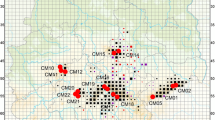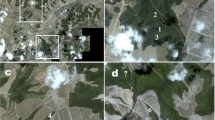Abstract
In this study, genetic diversity, inbreeding, spatial genetic structure (SGS), and pollen dispersal are analyzed using ten microsatellite loci from two populations of the dioecious, wind-pollinated, coniferous tree Araucaria angustifolia in Southern Brazil. The study populations include an undisturbed 7 ha A. angustifolia cluster, where all adult trees were mapped and sampled, and an adjacent, long-abandoned, open agricultural area with an aggregated A. angustifolia population. Seeds were collected from 13 seed trees inside the forest cluster and from eight seed trees in the open forest. Our results showed that the adults present high levels of heterozygosity (H o = 0.91) and an absence of inbreeding. However, significant SGS was detected up to 90 m in the forest cluster suggesting that near-neighbor trees are related. The estimate of effective population size was lower than the total number of trees in the cluster (N e/N = 0.19), which can be explained by the presence of SGS in the stand. Substantial external pollen flow was detected in the forest cluster (26 %) and open forest (20 %), indicating that the reproductive population size is greater than the sampled populations, explaining the high genetic diversity in this population. Our results indicate that this site has potential for in and ex situ conservation due to high levels of genetic diversity and gene immigration resulting from pollen flow. Conservation strategies for A. angustifolia should focus not only on forest fragments but should also include the preservation of isolated trees throughout the landscape.


Similar content being viewed by others
References
Adams WT (1992) Gene dispersal within forest tree populations. New For 6:217–240. doi:10.1007/978-94-011-2815-5_12
Ashley MV (2010) Plant parentage, pollination, and dispersal: how DNA microsatellites have altered the landscape. Crit Rev Plant Sci 29:148–161. doi:10.1080/07352689.2010.481167
Austerlitz F, Smouse PE (2001) Two-generation analysis of pollen flow across a landscape. II. Relation between ΦFT, pollen dispersal and interfemale distance. Genetics 157:851–857
Bacles CFE, Burczyk J, Lowe AJ, Ennos RA (2005) Historical and contemporary mating patterns in remnant populations of the forest tree Fraxinus excelsior L. Evolution 59:979–990. doi:10.1111/j.0014-3820.2005.tb01037.x
Bittencourt JVM, Sebbenn AM (2007) Patterns of pollen and seeds dispersal in a small, fragmented population of the wind-pollinated tree Araucaria angustifolia in southern Brazil. Heredity 99:580–591. doi:10.1038/sj.hdy.6801019
Bittencourt JVM, Sebbenn AM (2008) Pollen movement within a continuous forest of wind-pollinated Araucaria angustifolia, inferred from paternity and TwoGener analysis. Conserv Genet 9:855–868. doi:10.1007/s10592-007-9411-2
Bittencourt JVM, Sebbenn AM (2009) Genetic effects of forest fragmentation in high-density Araucaria angustifolia populations in Southern Brazil. Tree Genet Genomes 5:573–582. doi:10.1007/s11295-009-0210-4
Bittencourt JVM, Higa AR, Mazza MCM et al (2004) Conservation, management and sustainable use of Araucaria angustifolia genetic resources in Brazil. In: Vinceti B, Amaral W, Meilleur B (eds) Challenges in managing forest genetic resource for livelihoods: examples from Argentina and Brazil. IPGRI- International Plant Genetic Resources Institute, Rome, pp 133–148
Burczyk J, Adams WT, Shimizu JY (1996) Mating patterns and pollen dispersal in a natural knobcone pine (Pinus attenuate L.) stand. Heredity 77:251–260. doi:10.1038/hdy.1996.139
Burczyk J, DiFazio SP, Adams WT (2004) Gene flow in forest trees: how far do genes really travel? For Genet 11:179–192, http://www.as.wvu.edu/~sdifazio/peer8.pdf
Carvalho PER (2003) Espécies arbóreas brasileiras. Embrapa Florestas, Colombo
Carvers S, Degen B, Caron H et al (2005) Optimal sampling strategy for estimation of spatial genetic structure in tree populations. Heredity 95:281–289. doi:10.1038/sj.hdy.6800709
Cascante A, Quesada M, Lobo JJ, Fuchs EA (2002) Effects of dry tropical forest fragmentation on the reproductive success and genetic structure of the tree Samanea saman. Conserv Biol 16:137–147. doi:10.1046/j.1523-1739.2002.00317.x
Cockerham CC (1969) Variance of gene frequencies. Evolution 23:72–84. doi:10.2307/2406485
Danner MA, Ribeiro JZ, Zanette F et al (2013) Impact of monoecy in the genetic structure of a predominately dioecious conifer species, Araucaria angustifolia (Bert.) O. Kuntze. Plant Syst Evol 299:949–958. doi:10.1007/s00606-013-0775-0
Dow BD, Ashley MV (1996) Microsatellite analysis of seed dispersal and parentage of sampling in bur oak, Quercus macrocarpa. Mol Ecol 5:615–627. doi:10.1111/j.1365-294X.1996.tb00357.x
El Mousadik A, Petit RJ (1996) High level of genetic differentiation for allelic richness among populations of the argan tree [Arginia spinosa (L.) Skeels] endemic to Morroco. Theor Appl Genet 92:832–839. doi:10.1007/BF00221895
Frankham R, Ballou JD, Briscoe DA (2005) Introduction to conservation genetics. Cambridge University Press, Cambridge
Goudet J (1995) Fstat (Version 2.9.3.2.): a computer program to calculate F-statistics. J Hered 86:485–486, http://jhered.oxfordjournals.org/content/86/6/485.full.pdf+html Accessed 24 March 2014
Hamrick JL (2004) Response of forest trees to global environmental changes. For Ecol Manag 197:323–335. doi:10.1016/j.foreco.2004.05.023
Hardy O, Vekemans X (2002) SPAGeDI: a versatile computer program to analyze spatial genetic structure at the individual or population levels. Mol Ecol Notes 2:618–620. doi:10.1046/j.1471-8286.2002.00305.x
Hardy OJ, Maggia L, Bandou E et al (2006) Fine-scale genetic structure and gene dispersal inferences in 10 neotropical tree species. Mol Ecol 15:559–571. doi:10.1111/j.1365-294X.2005.02785.x
Isagi Y, Tateno R, Matsuki Y et al (2007) Genetic and reproductive consequences of forest fragmentation for populations of Magnolia obovata. Ecol Res 22:382–389. doi:10.1007/2F978-4-431-73238-9_3
Jones FA, Hamrick JL, Peterson CJ, Squiers ER (2006) Inferring colonization history from analyses of spatial genetic structure within populations of Pinus strobus and Quercus rubra. Mol Ecol 15:851–861. doi:10.1111/j.1365-294X.2005.02830.x
Jump AS, Penuelas J (2006) Genetic effects of chronic habitat fragmentation in a wind-pollinated tree. PNAS - Proc Natl Acad Sci 103:8096–8100. doi:10.1073/pnas.0510127103
Kalinowski ST, Taper ML, Marshall TC (2007) Revising how the computer program CERVUS accommodates genotyping error increases success in paternity assignment. Mol Ecol 16:1099–1106. doi:10.1111/j.1365-294X.2007.03089.x
Kellermann B, Lacerda AEB, Rosot MAD (2013) Bamboo influence on natural regeneration—a case study in a Araucaria Forest fragment in Brazil. In: Congreso Latinoamericano de IUFRO. San José, Costa Rica. http://www.alice.cnptia.embrapa.br/bitstream/doc/961130/1/Bamboo.pdf Accessed 24 March 2014
Kettle CJ, Hollingsworth M, Jaffré T et al (2007) Identifying the early genetic consequences of habitat degradation in a highly threatened tropical conifer, Araucaria nemorosa Laubenfels. Mol Ecol 16:3581–3591. doi:10.1111/j.1365-294X.2007.03419.x
Lacerda AEB, Rosot MAD, Filho AF et al. (2012) Sustainable forest management in rural Southern Brazil: exploring participatory forest management planning. In: Martin-Garcia J and Diez JJ (eds), Sustainable Forest Management - Case Studies, InTech, pp97-118. doi: 10.5772/2482
Levin DA (1988) The paternity pool plants. Am Nat 132:309–317, http://www.jstor.org/stable/2461984 Accessed 24 March 2014
Lindgren D, Mullin TJ (1998) Relatedness and status number in seed orchard crops. Can J For Res 28:276–283. doi:10.1139/cjfr-28-2-276
Loiselle BA, Sork VL, Nason J, Graham C (1995) Spatial genetic structure of a tropical understory shrub, Psychotria officinalis (Rubiaceae). Am J Bot 82:1420–1425
Mantovani A, Morellato LPC, Reis MS (2006) Internal genetic structure and outcrossing rate in a natural population of Araucaria angustifolia (Bert.) O. Kuntze. J Hered 97:466–472. doi:10.1093/jhered/esl031
Marshall TC, Slate J, Kruuk LEB, Pemberton JM (1998) Statistical confidence for likelihood based paternity inference in natural populations. Mol Ecol 7:639–655. doi:10.1046/j.1365-294x.1998.00374.x
Martinelli G, Moraes MA (2013) Livro vermelho da flora do Brasil. Instituto de Pesquisas do Jardim Botânico do Rio de. Janeiro, Rio de Janeiro
Mattos PP, Oliveira MF, Agustini AF et al (2010) Aceleração do crescimento em diâmetro de espécies da Floresta Ombrófila Mista nos últimos 90 anos. Pesq Flor Bras 30:319–326. doi:10.4336/2010.pfb.30.64.319
Mazza MCM, Bittencourt JVM (2000) Extração de DNA de tecido vegetal de Araucaria angustifolia (Araucariaceae). Bol Pesq Flor 41:12–17, http://www.cnpf.embrapa.br/publica/boletim/boletarqv/boletim41/mazzapdf Accessed 24 March 2014
Meagher TR (1986) Analysis of paternity within a natural population of Chamaelirium luteum. 1. Identification of most-likely male parents. Am Nat 128:199–215, http://www.jstor.org/stable/2461545 Accessed 24 March 2014
Meagher TR, Thompson E (1987) Analysis of parentage for naturally established seedlings of Chamaelirim luteum (Liliaceae). Ecology 68:803–812. doi:10.2307/1938351
Ng KKS, Lee SL, Saw LG et al (2006) Spatial structure and genetic diversity of three tropical tree species with different habitat preferences within a natural forest. Tree Genet Genomes 2:121–131. doi:10.1007/s11295-006-0035-3
Robertson A, Hollingsworth PM, Kettle CJ et al (2004) Characterization of nuclear microsatellites in New Caledonian Araucaria species. Mol Ecol Notes 4:62–63. doi:10.1046/j.1471-8286.2003.00569.x
Sant’Anna CS, Sebbenn AM, Klabunde GHF et al (2013) Realized pollen and seed dispersal within a continuous population of the dioecious coniferous Brazilian pine [Araucaria angustifolia (Bertol.) Kuntze]. Conserv Genet 14:601–613. doi:10.1007/s10592-013-0451-5
Salgueiro F, Caron H, de Souza MIF, Kremer A, Margis R (2005) Characterization of nuclear microsatellite loci in South American Araucariaceae species. Mol Ecol Notes 5:256–258
Schmidt AB, Ciampi AY, Guerra MP, Nodari RO (2007) Isolation and characterization of microsatellite markers for Araucaria angustifolia (Araucariaceae). Mol Ecol Notes 7(2):340–342 doi:10.1111/j.1471-8286.2006.01602.x
Scott LJ, Shepherd M, Henry R J (2003) Characterization of highly conserved microsatellite loci in Araucaria cunninghamii and related species. Plant Syst Evol 236:115–123
Sebbenn AM, Carvalho ACM, Freitas MLM et al (2011) Low levels of realized seed and pollen gene flow and strong spatial genetic structure in a small, isolated and fragmented population of the tropical tree Copaifera langsdorffii Desf. Heredity 106:134–145. doi:10.1038/hdy.2010.33
Sokal RR, Rohlf FJ (1995) Biometry: principles and practices of statistics in biological research. W. H. Freeman and Company, New York
Sousa VA, Robinson IP, Hattemer HH (2004) Variation and population structure at enzyme gene loci in Araucaria angustifolia (Bert.) O.Ktze. Silvae Genet 53:12–19, http://www.sauerlaender-verlag.com/fileadmin/content/dokument/archiv/silvaegenetica/53_2004/53-1-12.pdf Accessed 24 March 2014
Sousa VA, Sebbenn AM, Hattemer H, Ziehe M (2005) Correlated mating in populations of a dioecious Brazilian conifer, Araucaria angustifolia (Bert.) O. Ktze. For Genet 12:107–119, http://www.tuzvo.sk/files/fg/volumes/2005/FG12-2_105-119.pdf Accessed 24 March 2014
Stefenon VM, Gailing O, Finkeldey R (2007) Genetic structure of Araucaria angustifolia (Araucariacea) populations in Brazil: implications for the in situ conservation of genetic resources. Plant Biol 9:516–525. doi:10.1055/s-2007-964974
Stefenon VM, Gailing O, Finkeldey R (2008) The role of gene flow in shaping genetic structures of the subtropical conifer species Araucaria angustifolia. Plant Biol 10:356–364. doi:10.1111/j.1438-8677.2008.00048.x
Vekemans X, Hardy OJ (2004) New insights from fine-scale spatial genetic structure analysis in plant populations. Mol Ecol 13:921–935. doi:10.1046/j.1365-294X.2004.02076.x
White GM, Boshier DH, Powell W (1999) Genetic variation within a fragmented population of Swietenia humilis Zucc. Mol Ecol 8:1899–1909. doi:10.1046/j.1365-294x.1999.00790.x
Young AG, Boyle T, Brown ADH (1996) The population genetic consequences of habitat fragmentation for plants. Trends Ecol Evol 11:413–418. doi:10.1016/0169-5347(96)10045-8
Acknowledgments
The authors would like to acknowledge the Brazilian Council for Scientific and Technological Development (CNPq) and Brazilian Federal Agency for Support and Evaluation of Graduate Education (CAPES) for providing research fellowships to Luciano Medina Macedo, Juliana Zanetti Ribeiro, Carlos Ricardo Soccol, and Alexandre Magno Sebbenn. We also would like to acknowledge the Brazilian Agriculture Research Corporation (EMBRAPA) for logistics and financial support and the Federal University of Paraná (UFPR) and Technical Federal University of Paraná (UTFPR) for the infrastructure made available to realize this study. Finally, we thank Dr. Evelyn Nimmo for editing the English grammar of the manuscript and for two reviewers for their constructive criticism and suggestions which improved the scientific quality of this paper.
Data access
Genotyping and phenotyping data have been deposited at TreeGenes Data Repository accession TGDR028.
Author information
Authors and Affiliations
Corresponding author
Additional information
Communicated by P. Ingvarsson
Electronic supplementary material
Below is the link to the electronic supplementary material.
ESM 1
(PDF 28.4 kb)
Rights and permissions
About this article
Cite this article
Medina-Macedo, L., Sebbenn, A.M., Lacerda, A.E.B. et al. High levels of genetic diversity through pollen flow of the coniferous Araucaria angustifolia: a landscape level study in Southern Brazil. Tree Genetics & Genomes 11, 814 (2015). https://doi.org/10.1007/s11295-014-0814-1
Received:
Revised:
Accepted:
Published:
DOI: https://doi.org/10.1007/s11295-014-0814-1




